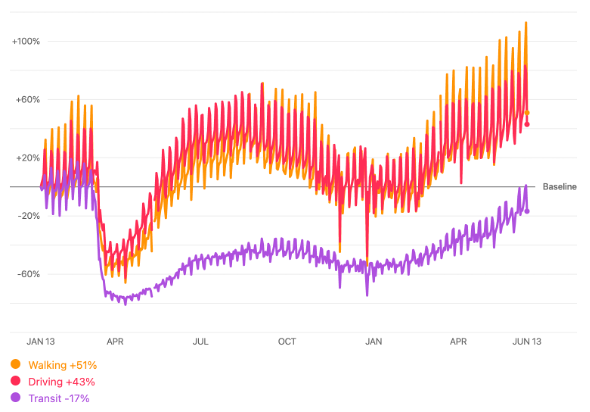On the Road (Again); Parking to Surge
Americans are on the move again. With vaccines widely available throughout the United States and about half of Americans vaccinated, people are starting to hit the road. The recent Memorial Day weekend saw a 500% increase in air travel alone, with nearly 11 million people flying over the holiday weekend and almost 35 million more embarking on Memorial Day road trips by car.
It’s understandable why Americans are anxious to travel again. After a year of COVID-induced shutdowns and enforced social distancing, which everyone agrees were necessary, the widespread availability of vaccines makes it safer to venture out. And people are itching to get back out.
Since January 13, 2020 (baseline), Apple has published data showing requests for walking, driving, or transit directions using its Maps app. Since the public’s desire for social distancing, it’s no surprise to see walking and driving (private passenger auto) directions requests well above the January 13th baseline, whereas transit directions inch towards “normal.”

Source: http://covid19.apple.com/mobility. Screenshot taken June 14, 2021.
It’s no question that more cars are on the road for a variety of reasons, so it’s fair to assume parking inventory will become hugely important; almost akin to retail currency.
Parking will likely see another inventory surge as offices re-open and “lunch-time” shopping and dinning in some malls will see spikes in usage.
It’s simple: More cars on the roads will mean more parking headaches.
Many cities (and quite a few suburban communities) suffer from inadequate parking inventory. Meaning, a city has more cars on the road than places to park. As a driver (or parker), it can be challenging and time-consuming to find available spaces. If it takes someone too long to find parking, restaurants, retailers, and entertainers risk economic losses. Cities address this by introducing “smart city” apps designed to help visitors, residents, and commuters find parking and access public transportation. The apps link drivers to city-wide parking guidance grids connecting them to municipal and privately owned and operated parking garages and lots. As cities invest, curbside parking will also become available on these apps.
But, parking guidance technology is the linchpin. By guiding drivers towards available parking, the technology provides a much better parking experience while reducing congestions on city streets and increasing shopping and dining time.
The name of the game is cycle time. The quicker a parking space flips, the faster someone else has an opportunity to shop, grab a meal, or catch a show. So, giving parkers an advantage has economic upside, especially as America is “(re)open(ing) for business.”
Fortunately, parking guidance technology has evolved significantly in recent years, and it’s more affordable and easier to use than ever before. Cities and parking owners don’t have to choose between expensive infrastructure-heavy sensors and inaccurate systems. The introduction of intelligent guidance technology with machine learning offers 99% accuracy at a fraction of the cost of traditional single space systems.
The introduction of intelligent parking guidance technology will make parking guidance accessible to all parking owners as they seek to serve the growing number of cars on our roads, make their cities easier to navigate and help bring economic opportunity to those establishments their parking spaces serve.
Americans are on the move (again), and intelligent guidance technology will help them find a place to park when they’ve reached their destination.

